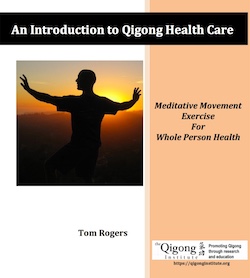American College of Sports Medicine Recommends Prescribing Qigong and Tai Chi
Multicomponent physical exercise such as Qigong and Tai Chi involve varying combinations of flexibility, neuromotor, and resistance exercise. Neuromotor exercise training is especially beneficial for older persons, especially to improve balance, agility, muscle strength, and reduce the risk of falls. The ACSM Position Stand on Developing and Maintaining Cardiorespiratory, Musculoskeletal, and Neuromotor Fitness in Apparently Healthy Adults recommends prescribing Qigong and Tai Chi. Guidance for Prescribing Exercise.
Harvard Medical School Guide to Tai Chi
Conventional medical science on the Chinese art of Tai Chi now shows what Tai Chi masters have known for centuries: regular practice leads to more vigor and flexibility, better balance and mobility, and a sense of well-being. Cutting-edge research from Harvard Medical School also supports the long-standing claims that Tai Chi also has a beneficial impact on the health of the heart, bones, nerves and muscles, immune system, and the mind. This research provides fascinating insight into the underlying biophysical, psychological, and social mechanisms of Tai Chi. Besides presenting the science behind Tai Chi, this book is a great introduction to Tai Chi. Harvard Medical School Guide to Tai Chi. Harvard Medical School's Harvard Health Publications calls Tai Chi "medication in motion." The health benefits of tai chi explains how Tai Chi when combined with standard treatment is helpful for a range of conditions including arthritis, low bone density, breast cancer, heart disease, heart failure, hypertension, Parkinson's disease, sleep problems, and stroke. Harvard Medical School Endorses Qigong and Tai Chi.
The Science of Tai Chi and Qigong and Whole Person Health Part I: Rationale and State of the Science. The emerging paradigm of whole person health shares many core principles with traditional complementary and integrative health frameworks, including Tai Chi and qigong (TCQ). In the Fall of 2023, the Harvard Medical School Osher Center for Integrative Health hosted the inaugural international conference on The Science of Tai Chi for Whole Person Health: Advancing the Integration of Mind-Body Practices into Contemporary Health Care held at Harvard Medical School. Part I summarizes the rationale for the conference and synthesizes the state of evidence for TCQ as rehabilitative and preventive tools for a range of clinical conditions, including falls and balance, cognition, mental health, sleep, cardiorespiratory health, musculoskeletal health, cancer, as well as translational evidence related to the neurophysiology, brain and immune function, and biomarkers of inflammation. The state of science of TCQ, viewed through the lens of traditional East Asian health constructs, is also discussed. PMID: 40091656.
The Science of Tai Chi and Qigong as Whole Person Health- Part II: Evidence Gaps and Opportunities for Future Research and Implementation. The emerging paradigm of whole person health shares many core principles with traditional complementary and integrative health frameworks, including Tai Chi and Qigong (TCQ). Part II summarizes evidence gaps and future research opportunities, including: understudied clinical conditions and populations, impact of long-term TCQ training, understanding the impact of specific TCQ styles, training regimens, dosage, and contextual effects; implementation, cost-effectiveness, and medical utilization research; individual data meta-analysis, and teaching competencies, credentialing, and licensure. PMID: 40229137.
What is the Whole Person Health Index?
What is whole person health?
Whole person health medical research and clinical practice involves the interaction of multiple physiolgocial systems and the therapeutic effects of multicomponent interventions focusing on improving health outcomes. Qigong is a multicomponent intervention that combines exercise, breathing, and awareness. Qigong Mind-Body Exercise as a Biopsychosocial Therapy for Persistent Post-Surgical Pain is a 2020 Harvard Medical School study on Qigong that describes Qigong as a mind-body exercise and biopsychosocial therapy. The methods of this study measured interoceptive awareness using the Multi-dimensional Assessment of Interoceptive Awareness (MAIA) and validate the research methods for scientifically investigating Qigong as a biopsychosocial interoceptive awareness practice and therapy: An Introduction to Qigong Health Care.
The United States National Institutes of Health (NIH) National Center for Complementary and Integrative Health (NCCIH) and the Veterans Administration are heavily promoting Whole Person Health and Whole Health research, practice, and therapy.
National Center for Complementary and Integrative Health
NCCIH: Whole Person Health: What It Is and Why It's Important? Whole person health involves looking at the whole person—not just separate organs or body systems—and considering multiple factors that promote either health or disease.... Instead of just treating a specific disease, whole person health focuses on restoring health, promoting resilience, and preventing diseases across a lifespan.
United States Department of Veterans Affairs - Veterans Administration
Veterans Administration Whole Health Information for Veterans: Introduction to Tai Chi and Qi Gong for Whole Health: Whole Health is an approach to health care that empowers and enables YOU to take charge of your health and well-being and live your life to the fullest. It starts with YOU. It is fueled by the power of knowing yourself and what will really work for you in your life.
Library of Research Articles on Veterans and CIH Therapies - Tai Chi/Qigong: Complementary and integrative health practices are growing in popularity, including use of movement-based therapies such as yoga, tai-chi, and qigong. Movement-based therapies are beneficial for a range of health conditions and are used more frequently by individuals with chronic illness.
Practice Qigong Now: VA|News Live Whole Health: #172: Posture, breath, and mind. #186: Slowing down with an introduction to Qigong. #209: The gentle power of Tai Chi
What Is My Whole Person Health Index?



